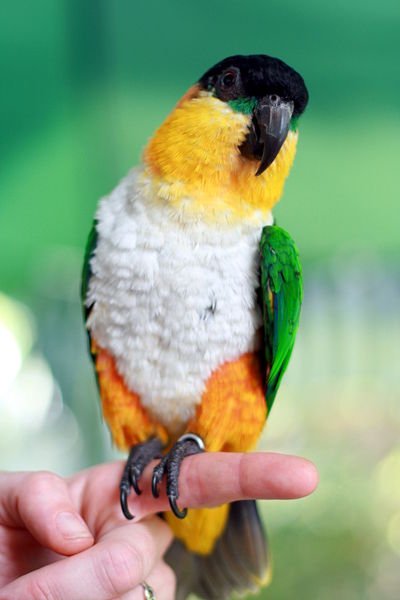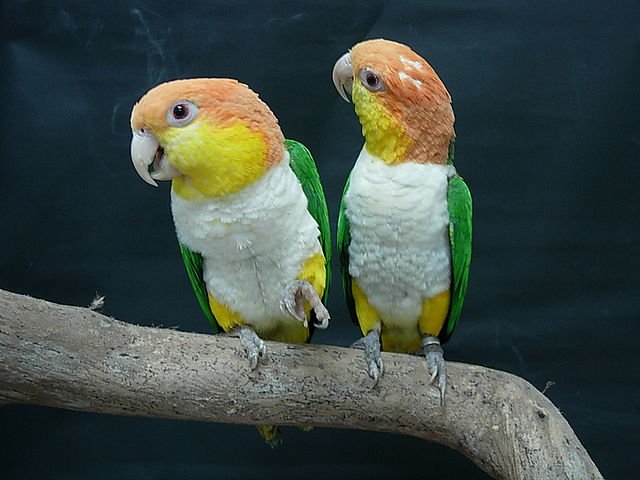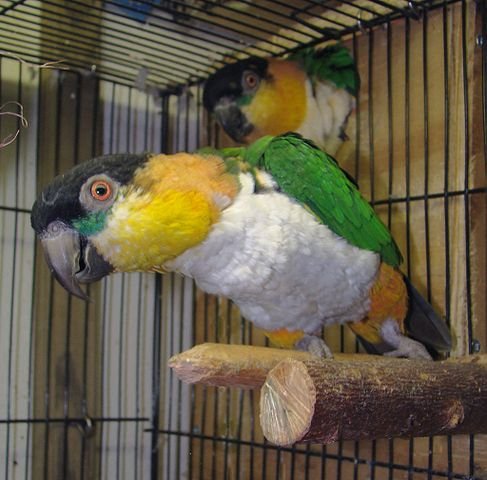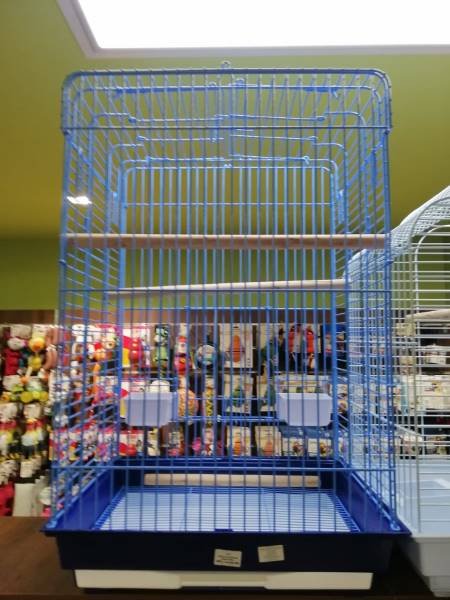Owing to the human activities, numerous plants, animals, and avian species have gone extinct and others are racing towards it. One such endangered parrot species is a beautiful White-Bellied Caique from the parrot kingdom. Though not petted by many, the avian lovers have recently shown their admiration for the species by adopting them over their other famous parrot family members.
White-Bellied Caique Habitat
Native to South American region, specifically to Brazil, Bolivia, and Peru, White-Bellied Caiques love to live in moist forests or swamps. They can be spotted living together with their flock of 25-30 birds. Though sometimes they can be seen in pairs too but never alone. Around 9 inches from head to toe, these parrots have an apricot-colored head and nape, yellow-colored neck, yellow or green thighs, white bellies, dark-green feathers, horn-colored beak, and grey feet.
One might find a few variations in the above-mentioned color taxonomy which is because these parrots have some subspecies.
White-Bellied Caique Names
Scientifically known as Pionites Leucogaster, the White-Bellied Caique has three subspecies that distinguishes him from the other species (Black-Headed Caique). These subspecies have very few differences:
Pionites Leucogaster Xanthomeria
Also known as Yellow-thighed Caique, this subspecies can be characterized by looking at his yellow thighs. This subspecies is the most commonly available and is the one Caique lovers happen to adopt.
Pionites Leucogaster Leucogaster
Also known as Green-thighed Caique, this subspecies of white-bellied Caique has visibly distinct green thighs.
Pionites Leucogaster Xanthurus
Also known as Yellow-tailed Caique, distinguishing this subspecies would need a little more than just a look at his thighs as this one also has yellow thighs just like Yellow-thighed Caique. But what makes him stand out from his cousin is relatively pale yellow thighs, a paler plumage, and a yellow-tail too.
White-Bellied Caique Lifespan
Not much has been reported on the white-bellied Caique lifespan. But it is known that the average life expectancy of a Caique is around 30 years depending on his habitat.
White-Bellied Caique Lifespan in the Wild
A white-bellied Caique’s life in the wild hasn’t been documented that much. But from the little known facts, he lives for an average of 27 to 30 years when in the wild. This is relatively lower than otherwise. And this can be attributed to his exposure to dangers in the wild or lack of care.
White-Bellied Caique Lifespan in Captivity
A white-bellied Caique’s life in captivity has a much better quality which makes him live way past than in the wild. They live for a minimum of 30 years in captivity with average care but if cared like a family member, they can prove to be a long-term companion, living for around 40 years. But to make this happen, Caiques would need a hands-on and a caring owner.
White-Bellied Caique Personality
Some parrot species are social, others are playful, and a few are cuddly. But a white-bellied Caique is not a species to be happy with a single personality trait. These mid-sized parrots are many personalities rolled into one.
Playful
White-Bellied Caique is all fun and playful. His comical antics have earned him the tag of being called as the clown of the parrot world. And he sure lives up to all these traits well. He is constantly on the go, to find his next best game that can keep him entertained better than the previous. Getting up and down the cage all day and hopping like a Kangaroo keeps the owner amused.

Energetic
Seeing a Caique in a typical day is like looking at a toddler high on sugar-rush, his energy is that uncontainable. Many owners call their Conures or Quakers energetic. But only until they meet a Caique.
The word ‘energetic’ doesn’t do justice to their real energy levels. Most of the time, owners find their Caiques on the cage’s floor, on their backs, and performing tricks back to back. They get huffed and puffed and start again, without having rested for a second. A white-bellied Caique owner is kept always on his feet by this little bird’s never-ending fun bouts.
Cuddly
Cuddly is not the aspect of a Caique’s personality that is discussed much. Though not as cuddly as a Cockatoo, Caiques are known to be cuddly enough to be termed as a personality trait. Those highlighting Caique’s aggressive trait must realize the fact that Caiques are companion birds for a reason. They can form a very close and strong bond with their human companion owing to their flock-nature. All that is needed is a conscious effort on the owner’s part to dedicate his time and effort to his pet bird. And in no time, the Caique would be on his lap, lying on his back, enjoying his owner’s company.
Moody
As comical, fun-loving and social a Caique can be, he can suddenly become nippy which can be accredited to his famous mood swings. A Caique can be the owner’s best friend, refusing to live without him for a moment, but he can nip his favorite human hard when he doesn’t want to be bothered. And the owner can hardly know his off-time beforehand. This is the reason it is always advised not to cohabitate a Caique even with any other bird. A Caique is infamous for attacking even his mate when under the influence of his mood swings.
White-Bellied Caique Temperament
Aggressive
Aggression is one of the most highlighted traits of a White-bellied Caique along with being comical. Their aggression can be little blamed on their extra-energetic nature. With always up for some prank, they get aggressive real quick if their energy is not fed continuously. The intensity of the aggression gets so high that, more often than not, they end up biting their favorite human. Hence, a Caique owner needs to arrest his bird’s biting behavior at the very beginning.
Territorial
Being territorial is that trait of a White-bellied Caique that has forced the owners to keep this bird alone in a cage, thereby, bringing him a bad reputation. They say a Caique must not be kept in the same cage as other bird pets as they will fight with a lot and might end up killing them. And sadly enough, this is not untrue. Many owner’s pet birds met the same fate. Others have complained that they have rescued their other birds from their Caique’s wrestling or kickboxing attack, simply because the Caique wanted to keep the whole big cage to himself
White-Bellied Parrot Talking Abilities
A white-bellied Caique isn’t known to be a great talker. Unlike other parrot species like Quaker or African Grey, Caiques can hardly mimic a word or two and that’s too, in a very unclear manner. Many Caiques can learn their name or, their owner’s name, or a few such words. But they mostly stick to, what is termed as, ‘bird language’. But one thing they can easily learn is to whistle or mimic certain sounds from the environment like door screeching or bell ringing. Also, they can sing songs by mimicking them, usually heard from their surroundings.
More about Caique Talking Training
White-Bellied Caique Diet
Diet plays an extremely important role in any bird’s diet to keep him healthy. And good health decides the number of years a bird will live for. A white-bellied Caique is no exception. He also needs a balanced and rich diet to stay happy and healthy.

Fresh Fruits and Vegetables
Like all other bird pets, Caiques also need their daily dose of fresh fruits and vegetables. One can feed the fruits and veggies chopped, sliced, or pureed depending on their bird’s preference. Feed them a good mix of both and keep rotating to offer them a good variety. Grapes, mangoes, strawberries are a few great fruit options. From the vegetables, offer them squash, spinach, carrot, or collard greens. Avoid all pitted fruits like avocado as they are toxic for a Caique’s digestive system.
Pellets
A good pellet mix is what keeps a Caique’s diet balanced by providing him what his diet might be lacking. A good and high-quality pellet mix has all the vitamins and minerals that are missing from the average diet of a Caique. The pellet mix should form at least 50 percent and, at the most, 70 percent of a Caique’s diet. Going below or above this range will lead to an unbalanced diet.
Seeds
A good seed mix is a must for a Caique, just like other pet birds. They can be fed either solely or a mix of chia seeds, quinoa, pumpkin seeds, etc. The seeds must be soaked for sometime before feeding them to the caique to make it easy for the bird to chew. Also, seeds must be fed only in very small quantities to a Caique to keep the balance of the diet intact. Lastly, owners must refrain, if possible, from feeding market-made seed mix to their Caiques as they can have added fats and preservatives that can harm the bird’s health.
Fresh Water
One life necessity without which no living being can survive is water and Caiques also need it, fresh and clean. Clean drinking water must always be present in a Caique’s cage to keep the bird hydrated all the time. Make sure that the water is drinkable and should either be filtered or boiled-cooled before being fed to the bird. Also, keep the supply constant, i.e., never let him sit thirsty inside the cage. Keep an eye on his drinking water bowl and refill it.
White-Bellied Caique Cage Needs
Like any other parrot species, a White-Bellied Caique cage needs are also important to be looked after. A cage is a place where he’ll spend most of his time and with 30-40 years in hand, it must be a home that fulfills all his necessities and comforts. And to ensure that everything is as it should be, one must consider the following factors:
Cage Size
Being a little ball of energy, always bustling, Caique must be kept in a cage large enough to offer him great mobility with ease. Hence, a cage of at least 24 inches in length, breadth, and height would prove to be an ideal cage for this super-energetic parrot.
The cage must have a few horizontal bars to let him sit and hop up and down the cage. The vertical spacing between the bars must be kept minimal keeping the safety of the bird in mind. In no way, the bird should be able to stick his neck inside those vertical gaps as he will end up hurting himself badly.
Cage necessities
Like all other bird pets, Caiques also need certain must-haves in their cage that can be termed as their daily necessities. And among them, feeders are the most important. A bowl to have a constant supply of fresh water, another for serving them their daily dose of fresh fruits and vegetables, and one to serve them the seed mix.
Though they can be kept on the cage’s floor, many owners prefer to hang them at various heights for their bird’s comfort. Instead of hanging, they can also be clipped to the cage’s bar with the help of clips. Lastly, add a few non-toxic perches for his daily flight needs.
Toys
Like any other fun-loving and playful parrot, White-Bellied Caiques also need something productive to channelize their high energy to prevent them from getting self-destructive. And there is nothing better than toys that can keep a super-active Caique engaged. But if the owner thinks that a few toys would be enough for this little parrot, they are in for a big surprise.
Caiques must not be taken at par in energy levels with other playful parrot species. Combine the energy levels of 2-3 active parrot species and you get a Caique. Keep multiple toys for this little parrot to keep him engaged and entertained all day. If the owner wouldn’t do this, a Caique would find his toys himself: probably a cutter in a stationary drawer, a knife or fork by flying into the kitchen or accidentally sticking himself inside the cage trying to pull a trick. This reminds us of the fact of never leaving a Caique unguarded while he’s out of the cage.
One can install various toys inside his white-bellied Caique’s cage. Ropes, spiral swings, ladders, foraging toys, textured balls, the options are many. The key is to keep his interest alive by getting him something new, different, or unpredictable.
White-Bellied Caique Breeding
A white-bellied Caique attains sexual maturity at an average age of 2 years. But most of them hardly breed before they turn 3. A female Caique normally lays around four eggs in a clutch but it becomes difficult for all four to survive especially the fourth chick. This is because it is difficult for a Caique pair to feed and rear all four together. Due to this, the third and the fourth chick is removed immediately after hatching to be hand-reared. Caiques can best raise two chicks.

The eggs are hatched after around 24- 27 days of incubation. The male Caique takes the responsibility of taking care of all the nest activities while the female incubates. The white-bellied Caique baby leaves the nest after about 10 weeks or so.
Read more about Caique Gender difference
https://parrotquaker.com/caique-parrot-gender-difference/
Read More about Breeding Here:
https://parrotquaker.com/caique-breeding/
Is White-Bellied Caique Loud/Noisy ?
Caiques aren’t known to be the noisiest parrot out there. Not even close to a Cockatoo. But that doesn’t prove them the silent one either. White-bellied Caiques happens to be in the middle of the noise spectrum. Though they give out their usual morning or evening contact calls that are loud and shrill, they can hardly hurt your ears.
That said, if one happens to live with someone sensitive to even a little noise, a Caique’s voice can be a bit too much for him. It is always advisable to visit a Caique at the pet store or adoption center first to get abreast with his vocalization levels. They aren’t noisy for a seasoned parrot owner but can be overwhelming for the ones who are accustomed to live with the more silent species.
What are the common health problems faced by Caique?
Caiques are a healthy parrot species in general. White-bellied caiques hardly face the many common health problems faced by other parrot species. That said, caiques are extremely susceptible to polyomavirus. The virus is found in young birds of under 4 weeks. It majorly causes severe gastroenteritis, thereby impacting the kidney, liver, and heart eventually. More often than not, the virus is deadly and can take away the life of the bird if not arrested in the initial stages.
The best way to prevent it is to get the bird vaccinated at the time of adoption. Or if the breeder/pet shop is claiming the bird to be vaccinated for it, get it verified by asking for the records. Also, though the disease is mainly contracted by young chicks, get the bird checked for the disease now and then in case there are other young caique chicks for a probable transmission. In that case, a booster vaccine dose would be needed.
Apart from this, a white-bellied caique might contract other common parrot illnesses like feather plucking, nasal discharge, beak swelling, coughing, et al. But any such illness would mean that the bird isn’t being taken care of well in captivity as caiques are one of the hardiest parrot species. They rarely fall prey to common diseases if fed well.
How can you tell if a Caique is male or female?
Caiques are sexually monomorphic and any difference; visual or behavioral, can hardly be relied upon for accurate gender determination. That said, many owners have claimed that the males tend to be aggressive. But the fact has never been stated in comparison to a female white-bellied being petted together. This is because female caiques are less in demand in the pet trade. Hence, this parameter of identifying the sex of the bird is incorrect.
The best way to find out a white-bellied caiques’ gender is to get the bird’s DNA tested. Apart from being 100% accurate, the method is also non-invasive and painless for the bird.
How much is a white-bellied caique?
Caiques aren’t as common in the pet trade as some other parrot species like budgies or Quakers. This makes them much more premium. They could cost anywhere between $1,000 to $2,000. And of both the genders, the females happen to be pricier than their male counterparts. This is because the females are more in demand only with the breeders than with the pet owners. So, to have a white-bellied caique at a lesser price, go for the male.
Are white-bellied caiques good pets?
White-bellied caiques have recently gained fame as great pets for their easy-going and extremely fun personality. They are always seen playing, hopping, and surfing on their backs. Another notable fact about their being good pets is their ease with which they can be trained. Many caique owners have claimed to teach their bird the basic ‘step-up’ training in under 10 minutes. Add to it their quickness at learning how to groom themselves and do potty the right way. They surely can prove to be the best pets out there.
Summing Up
A White-bellied Caique was long ignored by parrot lovers, though accidentally. But they are making up for their loss from the past few years. The yellow-thigh and the yellow-tail white-bellied subspecies are soon gaining the attention of all the bird lovers. This has led to these species being bred more nowadays, thereby adding to their decreasing numbers.
And with an increase in demand, comes more inquisitive Caique lovers who want to know everything before adopting these little clowns. But misinformation can be dangerous. And the biggest misinformation about a Caique is that they are just a hard-to-keep parrot. Had this been true, they wouldn’t have earned the tag of “clown of bird kingdom’.
Aggression and being territorial is just a part of their overall personality. And Caiques are more than this. They are social, fun, playful, comical, cuddly, and intelligent. And who knows if there are few more traits of their personality that are waiting to be unveiled.
Image used in the article: The original uploader was Be3n at English Wikipedia. / CC BY-SA (http://creativecommons.org/licenses/by-sa/3.0/)




